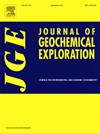Ore-forming processes of the Chuankou tungsten ore field, South China: New insights into Maowan quartz veins scheelite generation and mineralization genesis
IF 3.3
2区 地球科学
Q1 GEOCHEMISTRY & GEOPHYSICS
引用次数: 0
Abstract
The Maowan tungsten quartz vein-type deposit in the Chuankou W area in southern China is predominantly associated with Mesozoic granitic intrusion and Neoproterozoic rocks. Three generations of scheelite (Sch-1, Sch-2a, 2b, and Sch-3) in five types of granite mass were identified based on their occurrences, geochemistry analyses, and mineral paragenesis. The Mo concentration (MoO3) of scheelite decreases from 34.7 to 14.3 % (Sch-1) to 4.1–2.3 % (Sch-2a), then to 2.3–0.2 % (Sch-2b), and lastly to 0.9–0 % (Sch-3). Values of δ18Oscheelite and δ18Owolframite show relative homogeneous contents (6.62–8.30 ‰ and 7.55–9.56 ‰), while chalcopyrite δ34S ranges between −3.55–1.93 ‰. These changes in composition indicate early magmatism stage from moderate oxidizing to reducing conditions before returning to oxidizing at the late stage. Scheelite substitution mechanisms coupled with the correlation between REE and La reflect strong fluid–rock interactions within Nb-rich environments for Sch-1 and Sch-2, while Na-rich fluids are implied for Sch-3. Granites from Maowan W deposit exhibit two varieties of chondrite-normalized REE patterns, independent of scheelite classification. The type-1 is characterized by an obvious peak of W-enriched, whereas type-2 is MREE-depleted with strong negative Eu anomaly. The relatively wide variations in Nb/Ta vs. Sr and La vs. REE ratios among different generations of scheelite indicate that the hydrothermal fluids responsible for Sch-1 to Sch-3 were derived from remelted mixing fluids, likely associated with local extension under tectonic dominant regime. Study results on scheelite generation and REE precipitation events establish that ore-rich rocks first undergo early-stage metasomatism and filling, then partial fluid melting state releases abundant Ca- and Fe-rich minerals for either scheelite- or wolframite-bearing quartz veins, and refilling occurs through the contribution of recycled meteoric water at the late stage. The distinct variations in REE configuration in scheelite, within the ore field, reflect the multiple levels of mineralization during the metallogenic Episode I event in South China Block.
华南川口钨矿田成矿过程:茅湾石英脉、白钨矿生成及成矿成因新认识
华南川口W地区茅湾钨石英脉型矿床主要与中生代花岗质侵入岩和新元古代岩石有关。根据产状、地球化学分析和矿物共生特征,在5种花岗岩岩体中鉴定出3代白钨矿(Sch-1、Sch-2a、sch - 2b和Sch-3)。白钨矿的Mo浓度(MoO3)由34.7 ~ 14.3% (Sch-1)→4.1 ~ 2.3% (Sch-2a)→2.3 ~ 0.2% (Sch-2b)→0.9 ~ 0% (Sch-3)依次递减。δ 18白钨矿和δ 18钨钨矿含量相对均一,分别为6.62 ~ 8.30‰和7.55 ~ 9.56‰,黄铜矿δ34S含量介于- 3.55 ~ 1.93‰之间。这些成分的变化表明岩浆活动处于由中度氧化到还原的早期阶段,后期又回到氧化状态。白钨矿取代机制与REE和La的相关性反映了Sch-1和Sch-2富铌环境中强烈的流体-岩石相互作用,而Sch-3富钠流体暗示了富钠流体。毛湾钨矿花岗岩表现出两种不同的球粒陨石归一化稀土模式,与白钨矿分类无关。1型富w峰明显,2型贫mree,负Eu异常强烈。不同代白钨矿的Nb/Ta / Sr比值和La / REE比值差异较大,表明Sch-1 ~ Sch-3的热液来源于重熔混合流体,可能与构造主导下的局部伸展有关。白钨矿生成和REE降水事件研究结果表明,富矿岩先经历早期交代和充填,然后部分流体熔融状态释放出丰富的富钙、富铁矿物,形成含白钨矿或含黑钨矿的石英脉,并在后期通过循环大气水的贡献进行再充填。白钨矿REE配置在矿田内的明显变化,反映了华南地块成矿ⅰ期事件的多级成矿作用。
本文章由计算机程序翻译,如有差异,请以英文原文为准。
求助全文
约1分钟内获得全文
求助全文
来源期刊

Journal of Geochemical Exploration
地学-地球化学与地球物理
CiteScore
7.40
自引率
7.70%
发文量
148
审稿时长
8.1 months
期刊介绍:
Journal of Geochemical Exploration is mostly dedicated to publication of original studies in exploration and environmental geochemistry and related topics.
Contributions considered of prevalent interest for the journal include researches based on the application of innovative methods to:
define the genesis and the evolution of mineral deposits including transfer of elements in large-scale mineralized areas.
analyze complex systems at the boundaries between bio-geochemistry, metal transport and mineral accumulation.
evaluate effects of historical mining activities on the surface environment.
trace pollutant sources and define their fate and transport models in the near-surface and surface environments involving solid, fluid and aerial matrices.
assess and quantify natural and technogenic radioactivity in the environment.
determine geochemical anomalies and set baseline reference values using compositional data analysis, multivariate statistics and geo-spatial analysis.
assess the impacts of anthropogenic contamination on ecosystems and human health at local and regional scale to prioritize and classify risks through deterministic and stochastic approaches.
Papers dedicated to the presentation of newly developed methods in analytical geochemistry to be applied in the field or in laboratory are also within the topics of interest for the journal.
 求助内容:
求助内容: 应助结果提醒方式:
应助结果提醒方式:


